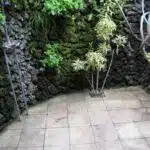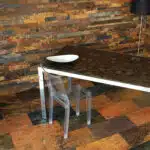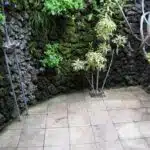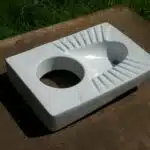Outdoor patios are a popular feature in many homes and can serve as an extension of living spaces, providing a comfortable and inviting outdoor environment for family and friends to gather. When designing or renovating an outdoor patio area, choosing the right type of tiles is crucial to ensure durability, safety, and aesthetic appeal. With a wide variety of materials available on the market, it can be overwhelming for homeowners to select the most suitable type of tile for their patio. As an expert in patio and outdoor tiles, I have researched and compiled a list of 14 different types of tiles that are perfect for outdoor patios.
From natural stone to porcelain and ceramic tiles, each type has its own unique features and benefits that make them ideal for specific purposes. Understanding these differences is essential in selecting the right tile that will not only complement the overall design but also withstand harsh weather conditions and heavy foot traffic. In this article, I will provide an overview of each type of tile along with its pros and cons to help homeowners make informed decisions when choosing tiles for their outdoor patios.
Natural Stone Tiles
Natural stone tiles are a popular choice for outdoor patios due to their unique and authentic appearance. These tiles are cut from various types of natural stone, including granite, limestone, travertine, and slate. Each type of natural stone tile has its own distinct look and texture, making it easy to find a style that complements the overall aesthetic of your patio.
One of the biggest pros of natural stone tiles is their durability. These tiles can withstand harsh weather conditions and heavy foot traffic without cracking or chipping. Additionally, they do not fade over time like some other materials do, which means they will maintain their beautiful appearance for years to come.
However, there are also some cons to consider when choosing natural stone tiles. They require more maintenance than other types of outdoor patio tiles because they are porous and prone to staining. To prevent this, it is recommended that you seal the tiles every year or two with a high-quality sealer designed specifically for natural stone. Regular cleaning with a pH-neutral cleaner is also important for maintaining the beauty of these tiles.
Moving onto porcelain tiles…
Porcelain Tiles
Having covered natural stone tiles in the previous section, it’s time to turn our attention to porcelain tiles. Porcelain is a type of ceramic tile that is made from a finer clay than standard ceramic tiles and fired at higher temperatures. This process results in a denser, more durable tile that is ideal for outdoor use.
One of the main advantages of using porcelain tiles for your patio is their durability. They are resistant to scratches and chips, as well as moisture and extreme temperatures. Additionally, they are easy to clean and require very little maintenance over time. However, one potential downside to porcelain tiles is that they can be more expensive than other types of outdoor tiles.
When it comes to installation, it’s important to take some precautions with porcelain tiles due to their weight and density. They should be installed on a solid base that can support their weight without cracking or shifting over time. Additionally, it’s recommended that a professional installer handles the job to ensure proper leveling and spacing between the tiles.
Moving on from porcelain tiles, let’s now explore another popular option for outdoor patios: ceramic tiles. These versatile tiles come in a range of colors and styles and offer many benefits for homeowners looking for an affordable yet stylish option for their outdoor space.
Ceramic Tiles
- Ceramic tiles are a popular choice for outdoor patio surfaces as they are durable, easy to maintain and come in a wide range of sizes and colors, allowing for custom designs.
- Installation of ceramic tiles requires precise measurements and cutting of tiles to fit the desired pattern.
- Ceramic tiles are a low-maintenance option for patios, needing only periodic sweeping and cleaning with a mild detergent and water.
- The advantages of ceramic tiles for outdoor patios include their durability and resistance to fading and discoloration from the sun and other elements.
- Sealing ceramic tiles is an important step in the installation process and helps make them more resistant to staining and water damage.
- Regular maintenance of ceramic tiles for outdoor patios is important to ensure their longevity and beauty, including sweeping and cleaning the surface regularly and reapplying sealant every few years.
Advantages
Ceramic tiles are an excellent choice for outdoor patios due to their durability and aesthetic qualities. They are made of a mixture of clay, sand, and other natural materials that make them highly resistant to weathering factors such as rain, sun exposure, and extreme temperatures. Moreover, they come in a wide range of sizes, shapes, colors, and patterns which allow homeowners to create unique designs that match their style preferences.
When it comes to the debate between durability vs aesthetics, ceramic tiles offer the perfect balance between both. They can withstand heavy foot traffic without showing signs of wear and tear while still maintaining their beautiful appearance over time. Furthermore, they are easy to clean and maintain which reduces the overall maintenance cost in the long run. This makes them an ideal choice for those who want a patio that looks great but is also practical.
Lastly, another advantage of ceramic tiles is their longevity. Unlike other types of outdoor tiles that tend to crack or fade over time, ceramic tiles can last for years without losing their quality or color. This makes them a smart investment for homeowners who want to add value and beauty to their property without having to replace their patio flooring frequently. All in all, ceramic tiles offer an excellent combination of durability, aesthetics, low maintenance cost vs longevity which make them one of the best options available for outdoor patios.
Installation
As a patio and outdoor tiles expert, one of the critical factors to consider when installing ceramic tiles is whether to go the DIY route or hire a professional. Installing ceramic tiles can be a daunting task, especially for those with no prior experience in tiling. However, with the right tools and knowledge, homeowners can save money by doing it themselves. On the other hand, hiring a professional ensures that the job is done correctly and efficiently, leaving you with a beautifully finished patio.
DIY vs Professional: Pros and Cons One of the main advantages of DIY installation is cost savings. By doing it yourself, you avoid labor costs which are typically included in professional installation prices. Additionally, you have more control over the project’s timeline and can work at your own pace. However, DIY installation requires time, patience, and technical know-how which not everyone may possess. On the other hand, hiring a professional comes with higher costs but guarantees quality workmanship and expertise.
Cost Comparison: DIY vs Hiring a Professional When it comes to cost comparison between DIY installation and hiring professionals for ceramic tile installation on your outdoor patio, several factors come into play. These include tile type (size and pattern), area size to be tiled (in sq.ft), labor costs (if any), and any additional materials needed such as adhesive or grout. While DIY installations may seem cheaper upfront due to lower labor costs, hidden expenses like tools rental or mistakes leading to rework could end up costing more in the long run. Therefore homeowners should weigh their options carefully before making their final decision on whether to undertake this project themselves or hire professionals for assistance.
Maintenance
As a patio and outdoor tiles expert, it is crucial to understand that proper maintenance of ceramic tiles is essential in ensuring their longevity and aesthetic appeal. Regular maintenance helps to prevent wear and tear, cracks, and stains that could arise due to harsh weather conditions, heavy foot traffic or spills. While DIY maintenance tips could help homeowners save money, hiring professional maintenance services guarantees a comprehensive and thorough cleaning that can extend the lifespan of your ceramic tiles.
DIY maintenance tips for ceramic tiles include regular sweeping or vacuuming to remove dirt and debris. Additionally, wiping down the tiles with a damp mop using gentle soap solution can help to remove stubborn stains. Homeowners should avoid using abrasive cleaners or tools such as steel wool pads as they could cause scratches on the surface of the tiles. For outdoor patios, sealing the grout lines annually can help protect against water damage.
Professional maintenance services offer deep cleaning options like steam cleaning which effectively removes all dirt buildup from porous surfaces while leaving no residue behind. Additionally, professional cleaning services have specialized equipment that can handle tough stains without damaging the tiles’ surface. Hiring professionals for regular maintenance services also allows them to identify any potential issues before they become worse and require costly repairs.
In conclusion, proper ceramic tile maintenance is essential in enhancing their aesthetic appeal and prolonging their lifespan. While DIY maintenance tips may seem cost-effective upfront, homeowners must weigh the benefits of hiring professional maintenance services in terms of expertise, efficiency and thoroughness in maintaining their outdoor patio’s beauty.
Quarry Tiles
Quarry tiles are a popular choice for outdoor patios due to their durability and aesthetic appeal. They are made from natural clay, which is fired at high temperatures to create a hard, dense tile that can withstand heavy foot traffic and the elements. Quarry tiles come in a range of colors and finishes, allowing homeowners to choose a style that best suits their outdoor space.
When it comes to durability vs. aesthetics, quarry tiles strike the perfect balance. They are strong enough to withstand harsh weather conditions, such as freezing temperatures and heavy rain, while also providing an attractive surface for outdoor entertaining. Unlike some other tile materials, quarry tiles do not require sealing or special maintenance, making them a cost-effective choice in the long run.
In terms of cost comparison to other tile materials, quarry tiles are moderately priced. While they may be more expensive than some synthetic options like concrete pavers or interlocking tiles, they are typically less expensive than natural stone varieties like slate or granite. Homeowners on a budget can still achieve an upscale look with quarry tiles without breaking the bank.
Next up: slate tiles! These natural stone tiles offer a unique texture and color palette that can add elegance and sophistication to any outdoor space. Let’s take a closer look at what makes slate tiles such a popular choice for patios and other outdoor areas.
Slate Tiles
As a patio & outdoor tiles expert, I must admit that slate tiles are one of my favorite options for outdoor spaces. Not only do they bring a touch of elegance and natural beauty to any area, but they also offer numerous benefits that make them a wise investment. If you’re considering slate tiles for your patio or outdoor area, read on to discover why they may be the perfect choice for you.
First and foremost, one of the most significant benefits of slate tiles is their durability. These tiles are incredibly dense and strong, making them resistant to chips and cracks caused by everyday wear and tear. They can withstand harsh weather conditions, including heavy rain, snow, and extreme heat, without losing their color or texture. This resilience makes them an ideal option for high-traffic areas that receive a lot of foot traffic.
Another advantage of slate tiles is their low maintenance requirements. Unlike other materials like wood or concrete that require frequent cleaning and sealing, slate tiles only need occasional sweeping and mopping with mild soap and water to keep them looking pristine. However, it’s crucial to avoid using harsh chemicals or acidic cleaners as they can damage the surface of the tile.
To ensure your slate tiles last for years to come, there are some maintenance tips you should follow. Firstly, always clean up spills immediately to prevent stains from setting in. Secondly, seal your slate tiles every few years to protect them from moisture penetration and staining. Lastly, avoid dragging heavy furniture across the surface as it can scratch or damage the tile.
Now that you know about the benefits of slate tiles and how to maintain them properly let’s take a look at another popular option: marble tiles.
Marble Tiles
Slate tiles are a popular option for outdoor patios due to their unique texture and natural beauty. However, they may not be the best choice for all homeowners. If you’re looking for something with a more polished look, consider marble tiles.
Marble is a highly durable material that can withstand harsh weather conditions and heavy foot traffic. It’s also available in a wide range of colors and patterns, making it easy to find something that complements your home’s exterior design. When it comes to cleaning techniques, marble is relatively low maintenance. Simply sweep or hose down the surface regularly to prevent dirt buildup.
Installing marble tiles requires expertise and precision. The process involves preparing the surface, laying out the tiles in a pattern, cutting them to fit around any obstacles, applying adhesive and grout, and sealing the finished product. It’s important to hire an experienced contractor who can ensure that every step of the installation process is done correctly.
Transition: Now that we’ve covered marble tiles, let’s move on to another popular option for outdoor patios – travertine tiles.
Travertine Tiles
Travertine Tiles: The Epitome of Elegance and Durability
If you want your patio to emanate sophistication, then Travertine tiles are the way to go. These tiles have been used since ancient times in various architectural marvels like the Colosseum, proving their durability over centuries. Their natural beauty is unmatched and gives an earthy feel to any outdoor space. The unique texture and pattern of these natural stones make them a popular choice amongst architects and designers.
Travertine maintenance is relatively easy compared to other outdoor tile options. A simple clean with soap water or pH-neutral stone cleaner will suffice. However, it’s essential to seal the tiles regularly to avoid damage from moisture absorption. As compared to porcelain tiles, Travertine has a higher porosity level, making them prone to staining if not sealed timely.
Here are some key differences between Travertine and porcelain tiles that will help you make an informed decision:
- Travertine is a natural stone, whereas porcelain is a man-made ceramic material.
- Porcelain requires minimal maintenance as it’s less porous than Travertine.
- Porcelain comes in a wide range of colors and patterns, whereas Travertine has more limited options.
- Travertine has superior strength and durability as compared to porcelain.
Now that you know all there is about Travertine tiles let’s move on to the next option – cement tiles!
Cement Tiles
Cement tiles are a popular choice for outdoor patios due to their elegant and classic appeal. These tiles come in various designs and colors, making them a versatile option for homeowners who want to create their desired patio look. One of the most attractive design options is encaustic cement tiles, which feature vibrant patterns that add visual interest to any patio. Additionally, cement tiles can be customized to fit unique patio shapes and sizes.
Aside from their aesthetic appeal, cement tiles also offer durability benefits. Unlike other materials like wood or natural stone, cement tiles are resistant to water damage, fading, and staining. This makes them an ideal choice for outdoor spaces that are exposed to harsh weather conditions or heavy foot traffic. Cement tiles are also low-maintenance and easy to clean, requiring only occasional sweeping and mopping.
Overall, cement tiles are an excellent investment for homeowners who want a long-lasting and stylish patio surface. With their wide range of design options and durability benefits, these tiles offer both form and function for outdoor spaces. If you’re considering cement tiles for your patio, it’s important to work with a reputable installer who can ensure proper installation techniques for optimal performance.
As we continue our exploration of different types of outdoor patio tiles, the next material on our list is glass tiles. Similar to cement tiles, glass offers unique design options that can suit a variety of styles – from sleek modern looks to colorful mosaic patterns. Let’s take a closer look at the benefits of glass tiles for outdoor patios in the next section.
Glass Tiles
Glass Tiles: A Stunning and Durable Option for Outdoor Patios
Glass tiles are a popular choice for outdoor patios due to their unique visual appeal and durability. One of the main advantages of glass tiles is their versatility in design, as they come in various colors, sizes, and shapes that can be arranged in patterns or mosaics. Glass tiles are also highly reflective, which adds depth and sparkle to any patio area.
The installation of glass tiles for outdoor patios requires a bit more skill than other tile options, such as ceramic or porcelain. The surface must be even and free of debris before installation, and the adhesive must be carefully applied to prevent air pockets from forming underneath the tiles. However, with proper installation techniques, glass tiles can withstand extreme weather conditions without fading or cracking.
Maintenance is an important consideration when choosing outdoor patio tiles, and glass tiles require minimal upkeep compared to other options. They are resistant to stains and mold growth due to their non-porous surface, making them easy to clean with just soap and water. Additionally, glass tiles do not require sealing, which saves time and money on maintenance costs in the long run.
Moving onto our next option – brick tiles – let’s explore how they offer a classic look while being durable enough to withstand harsh weather conditions.
Brick Tiles
Glass tiles offer a unique and modern look for outdoor patios, but they may not be the most practical option for everyone. For those looking for a more traditional and durable choice, brick tiles are an excellent alternative. Brick tiles come in a variety of colors and sizes, making them versatile for any patio design.
Benefits of using brick tiles:
- Durability: Brick is known for its strength and longevity, making it a great choice for high traffic areas.
- Slip-resistant: The texture of brick makes it slip-resistant even when wet, which is important for safety on outdoor patios.
- Low maintenance: Brick requires minimal upkeep compared to other materials like wood or concrete.
- Aesthetics: The natural look of brick can add warmth and charm to any outdoor space.
- Sustainable: Bricks are made from natural materials like clay or shale, making them an eco-friendly option.
Maintenance tips for brick tiles:
- Regularly sweep or use a leaf blower to remove debris from the surface.
- Use a mild detergent with warm water to clean any stains or spills on the surface.
- Avoid using harsh chemicals or power washers that could damage the surface of the brick.
- Keep an eye out for any cracks or damage that may need to be repaired promptly.
- Apply sealant every few years to protect against moisture and prolong the life of the bricks.
Brick tiles offer many benefits when it comes to choosing the right material for your outdoor patio. From their durability and safety features to their low maintenance requirements and sustainability, they are an excellent investment. By following some simple maintenance tips, you can ensure your brick tiles last for years to come. Up next, we will explore another popular option – mosaic tiles.
Mosaic Tiles
Mosaic tiles are a popular choice for outdoor patios due to their unique design and durability. They are made up of small pieces of colored glass, stone, or ceramic arranged in intricate patterns. The variety of colors and textures available make mosaic tiles an excellent option for creating a customized look that complements the homeowner’s personal style.
One of the advantages of mosaic tiles is their durability. They can withstand harsh weather conditions, making them an ideal choice for outdoor spaces. Additionally, they require little maintenance and are easy to clean. However, one disadvantage is that they can be more expensive compared to other types of patio tiles.
When it comes to designing with mosaic tiles, the possibilities are endless. Homeowners can opt for a classic pattern such as Greek key or create something unique with a custom design. Mosaic tiles can also be used to create a focal point on the patio, such as a colorful tile rug or accent wall. Another idea is to incorporate different shades of blue and green mosaic tiles to mimic the look of water for a serene oasis-like atmosphere.
Overall, mosaic tiles offer numerous design ideas and benefits for outdoor patios. While they may come with some cons such as being more expensive than other options, their durability and versatility make them worth considering when planning your outdoor space. Next up we will explore wood tiles which offer another unique look for your patio area.
Wood Tiles
Wood Tiles: Pros and Cons, Installation Tips
As an expert in patio and outdoor tiles, I have seen the increasing popularity of wood tiles for outdoor patios. Wood tiles are a great option for those who want the natural, warm look of wood without the maintenance that comes with traditional wood decks. However, like any other product, wood tiles come with its own set of pros and cons.
One of the advantages of wood tiles is its natural beauty. They provide a warm and inviting atmosphere to any outdoor space. Additionally, wood tiles are relatively easy to install compared to traditional wood decks. They can be easily snapped together with interlocking systems or installed using pedestals or adjustable height systems. However, wood tiles require regular maintenance such as sealing and staining to prevent rotting and fading.
On the other hand, one disadvantage of wood tiles is their susceptibility to weather damage. Since they are made from natural materials, they can warp and crack over time due to exposure to extreme temperatures or moisture. Furthermore, they may not be suitable for high-traffic areas since they can scratch or dent easily.
When installing wood tiles for your patio or outdoor space, it is important to choose high-quality materials from trusted manufacturers. Proper installation techniques should also be followed to ensure durability and longevity. Overall, while there are some downsides when it comes to using wood tiles for outdoor patios, their benefits outweigh their disadvantages.
As we move on to the next section about composite tiles, it is important to note that these types of tiles offer a different set of advantages and disadvantages than those made from natural materials like wood.
Composite Tiles
Composite Tiles:
Composite tiles are a type of outdoor tile made from a mixture of materials such as recycled plastic, wood fibers, and other additives. These tiles offer an eco-friendly option for homeowners who want to create an outdoor space that is both durable and stylish. Composite tiles come in a variety of colors, textures, and designs, making them a versatile choice for any patio or outdoor area.
Maintenance tips for composite tiles include regular cleaning with mild soap and water to remove dirt and debris. It’s important to avoid using harsh chemicals or abrasive cleaners as they can damage the surface of the tile. Additionally, it’s recommended to sweep or blow off any leaves or debris that may accumulate on the surface of the tile to prevent mold growth. Although composite tiles may require less maintenance than other types of outdoor tiles, it’s still important to take care of them to ensure their longevity.
Cost comparison is an important factor when considering composite tiles for your patio or outdoor area. While they may be more expensive than some traditional options such as concrete or natural stone, composite tiles offer long-term cost savings due to their durability and low maintenance requirements. Additionally, many manufacturers offer warranties for their products which can provide added peace of mind for homeowners looking to invest in quality outdoor flooring.
Transitioning into the subsequent section about rubber tiles: Rubber tiles are another popular option for homeowners looking for an affordable and durable solution for their outdoor space. Let’s explore the benefits and considerations when choosing rubber tiles for your patio or outdoor area.
Rubber Tiles
Transition: Now that we have discussed the benefits of composite tiles for outdoor patios, let’s move on to another popular option – rubber tiles.
Have you ever considered using rubber tiles for your patio? Not only are they eco-friendly and durable, but they also offer various benefits. Rubber tiles are slip-resistant, making them a great choice for areas prone to moisture or rain. They also provide excellent shock absorption, making them ideal for families with young children or elderly individuals.
When it comes to installation tips for rubber tiles, preparation is key. First, ensure that the surface is clean and level. Any debris or unevenness can affect the longevity of the tile. Once you have a smooth surface, start by laying out the tiles in your desired pattern. Interlocking rubber tiles are a popular option as they eliminate the need for adhesive and make installation easier. Finally, trim any excess material around the edges with a utility knife to create a seamless finish.
As an expert in patio and outdoor tiles, I highly recommend considering rubber tiles for your next project. With their numerous benefits and easy installation process, they are an excellent choice for any homeowner looking to improve their outdoor space. In our next section, we will discuss how to choose the right tile for your patio based on factors such as design preferences and durability needs.
Choosing The Right Tile For Your Patio
Factors to consider when choosing the right tile for your patio are crucial as they will not only impact the overall look but also the functionality of your outdoor space. Before deciding on a particular type, you should consider factors such as durability, slip-resistance, weather-resistance, and maintenance. For instance, porcelain tiles are ideal for patios with high traffic because they are durable and require little maintenance.
Popular patio tile designs include natural stone tiles, concrete pavers, ceramic tiles, and glass tiles. Natural stone tiles like granite and slate are popular due to their natural beauty that adds an elegant touch to any outdoor space. Concrete pavers offer a low-cost option that is easy to install and maintain while still providing a wide range of design options. Ceramic tiles come in various patterns and colors that make them an excellent choice for homeowners who want to add some character to their patios. Glass tiles provide a unique aesthetic appeal as they reflect light, creating an illusion of depth.
When selecting the right type of tile for your patio, it’s essential to keep in mind what you want your outdoor living area to feel like. Do you want a warm and inviting atmosphere or a cool and modern vibe? Your answer will help guide you towards the best choice for your needs.
- Enjoy the beauty of nature with natural stone tiles.
- Create a contemporary look with glass tiles.
- Save on cost with concrete pavers.
- Add character with ceramic tile patterns.
- Ensure safety with slip-resistant materials.
Remember that choosing the right tile for your patio involves more than just aesthetics; it requires careful consideration of factors such as durability, slip-resistance, weather-resistance, and maintenance needs. With these considerations in mind, you can confidently select a tile that meets both your functional needs and personal style preferences.
Conclusion
As a patio and outdoor tiles expert, it is crucial to consider the type of tile that fits your needs. Just like how plants need different types of soil to grow, every homeowner has unique preferences for their patios. Each type of tile has its own advantages and disadvantages. It’s important to choose the best one based on factors such as durability, maintenance, and aesthetics.
In conclusion, selecting the right outdoor tiles is similar to choosing ingredients for a recipe. It’s not just about finding what’s available but also considering what works best for your needs. The beauty of patios lies in how they can transform any outdoor space into a comfortable and inviting area. With these 14 different types of tiles available, you can create a beautiful patio that complements your lifestyle and personality for years to come.
Image Credits
- “Patio” by kevin dooley (featured)





























![Calculating How Much Stone Dust You Need 29 [Blog Post]Stone Dust © Oxfam Australia](https://green-life.blog/wp-content/uploads/2023/05/GdZVzgTqPhjq-150x150.jpg.webp)